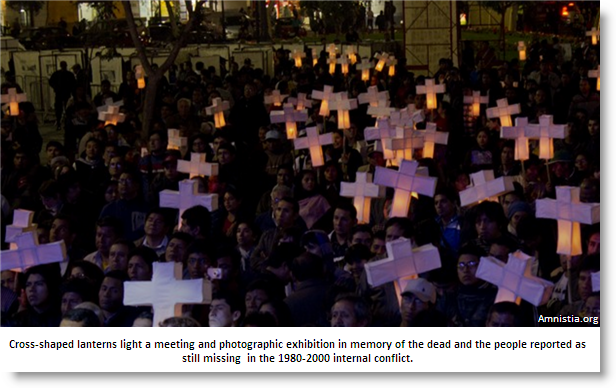A law on the Search for Missing Persons has been published today in the official gazette, El Peruano, to facilitate the search for persons who were reported missing during the two decades of internal conflict in Peru, between 1980 and 2000. The focus is to grant access to relatives and institutions to all information available on people who were reported missing during the conflict.
President Humala said the law has been enacted “to give justice to the families affected by the violence.”
 Law 30470, proposed by the People’s Ombudsman Office, was finally approved by Congress a month ago but only signed by President Humala yesterday. Local human rights groups and the Ombudsman’s office, as well as the United Nations and Amnesty International, were urging the President to sign the proposal into law before the end of his presidential term next month.
Law 30470, proposed by the People’s Ombudsman Office, was finally approved by Congress a month ago but only signed by President Humala yesterday. Local human rights groups and the Ombudsman’s office, as well as the United Nations and Amnesty International, were urging the President to sign the proposal into law before the end of his presidential term next month.
Approximately 16,000 people are still considered missing, according to the People’s Ombudsman Office, from data initially compiled by the Truth and Reconciliation Commission, CVR, in 2001-2003, which concluded that an estimated total of 69,280 people were dead and missing as a result of the armed conflict. The missing include young children, university students, whole groups of villagers, most of whom were either kidnapped by Shining Path or MRTA rebels or arrested or held for questioning by the military or police in conflict areas.
Searching for the people who disappeared in those two decades has been long and tedious, more often than not blocked either by bureacracy or intentionally in the cases of people who were last seen in police or military custody.
The government’s special forensic team was able to exhume 3,202 bodies between 2002 and 2015, most in unmarked mass graves. Of these, 1,833 have been identified — often through the painful process of identification “exhibitions” of items of clothing, and DNA tests —and given to their families for burial.
The new law rules that relatives of missing persons have “the right to know the truth about the circumstances of the disappearance, the status of the missing person, including their whereabouts or the circumstances of their death and the place of their burial.”
It also rules that the “State guarantees the rights and interests of the missing persons and their relatives, and in particular to carry out an effective, exhaustive and impartial investigation of the circumstances of the disappearance.”
The Ministry of Justice and Human Rights is to promote and supervise interventions focused on “the emotional and social recovery of the relatives” in the search process, and that “these interventions must be carried out in the corresponding language and should be culturally relevant.”
The first step is to be for the Ministry of Justice and Human Rights to “design, establish, execute and supervise” a national plan for the search of people who disappeared, and to create a National Registry of Missing Persons and Burial Sites as a central data base for cross-referencing all the work carried out by different institutions.





